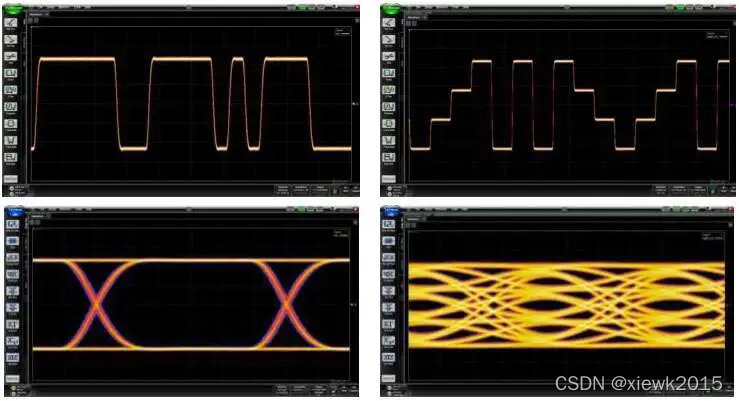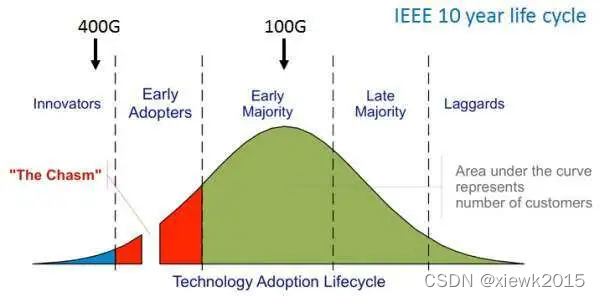本文主要是介绍PAM4: A new measurement science,希望对大家解决编程问题提供一定的参考价值,需要的开发者们随着小编来一起学习吧!
原文地址
This article is part of EDN and EE Times’ Hot Technologies: Looking ahead to 2016 feature, where our editors examine some of the hot trends and technologies in 2015 that promise to shape technology news in 2016 and beyond.
As the world’s insatiable appetite for data keeps growing, engineers must continuously develop new technologies to move bits ever faster. With 100 Gbps serial links in rapid deployment, engineers are under pressure to develop the next higher speed: 400 Gbps Ethernet and others are beginning to take shape. But, the shape of the waveforms looks to be quite different this time.
With previous speed increases, engineers have found ways to keep using the traditional NRZ (non-return-to zero) modulation where one baud carries one bit. But as individual links move from 25-28 Gbps to 50-56 Gbps, NRZ could be reaching its limit. That’s because the bandwidth required to carry NRZ could just be too much to be cost effective. Plain old PCBs just can’t handle it, making signal losses intolerable. NRZ just might be running out of steam. Of course, we’ve heard that before.
Enter PAM4 (four-level pulse-amplitude modulation) a topic of two panels and nine technical papers at DesignCon 2016. PAM4 should let you develop 56 Gbps data lanes with less signal loss than would occur by simply doubling the NRZ—sometimes called NRZ-PAM2—bit rate. Exotic PCB materials can compensate for the deficiencies, but at a cost few are willing to pay. PAM4 doubles the bit rate for a given baud rate over NRZ. Thus, a 28 Gbaud PAM4 signal can deliver the same bit rate as a 56 Gbaud NRZ signal. Figure 1 shows the difference between NRZ (left) and PAM4 (right).

Figure 1 An NRZ data stream (top left) uses two voltage levels and produces a single eye (bottom left). A PAM4 data stream (top right) uses four levels, producing three eyes (bottom right). (Image courtesy of Keysight Technologies)
Figure 1 An NRZ data stream (top left) uses two voltage levels and produces a single eye (bottom left). A PAM4 data stream (top right) uses four levels, producing three eyes (bottom right). (Image courtesy of Keysight Technologies)

Figure 2 This simulated PAM4 eye shows how the signal might be coded to get four levels and thus two bits per baud. (Image courtesy of SiSoft)
Figure 2 This simulated PAM4 eye shows how the signal might be coded to get four levels and thus two bits per baud. (Image courtesy of SiSoft)

Figure 3 A PAM4 receiver will need three slicers to detect the three eyes.
There are other tradeoffs, too. Take a look at the simulated PAM4 signal in Figure 2 . In the middle eye, the widest point is at half the eye’s amplitude. But, that’s not the same for the upper and lower eyes where the widest eye opening may occur at about the 1/3 or 2/3 point in the eye amplitude. The compression occurs because rise and fall times have finite speeds, cutting off parts of the eyes. The nonlinear eyes can result in DDJ (data-dependent jitter), a form of intersymbol interference.
Another issue with PAM is timing skew. In figures 2 and 3 , the simulated eyes are perfectly aligned in time, stacked directly on top of each other. Figure 4 shows that’s not always the case with real signals. Skew can occur, making the eyes even more difficult to properly detect.

Figure 4 Real PAM4 signals may be subject to skew. In this case the, upper and lower eyes lag the middle eye. (Image courtesy of Teledyne LeCroy)
While timing skew can occur in purely electrical signals if trace lengths are not the same, it’s more prominent when the signals pass through optical links. Steve Sekel, Strategic Product Planner at Keysight Technologies, explained that “timing skew occurs when you excite a VCSEL (vertical-cavity-surface-emitting laser) and directly drive the laser. Assume, for example that we designate the four signal levels as 0, 1, 2, 3 from bottom to top. A level 2-3 transition will arrive at the receiver faster than 0-1 transition because it starts at a higher voltage.”
These and other issues are forging new techniques for how to measure PAM4 signals. “One to two years ago, customers started coming to us asking what could we measure regarding PAM4,” said Connally. “We asked them what did they want to measure? The first thing we had to do was to see if we could trigger our oscilloscopes on a PAM4 signal. Creating an eye diagram requires that the oscilloscope recover the clock from the data. We found that we could get reliable triggers by using our NRZ clock-recovery and trigger algorithms.”
While it’s true that oscilloscopes (and receivers) need to recoverembedded clocks from incoming signals, it’s just a first step indetecting bits and bit errors. Remember, all these signaling issues comedown to bit errors. One such tool used to calculate bit errors is thebathtub curve. Because of the three eyes in a PAM4 signal, simplygenerating the traditional bathtub curve used for NRZ isn’t enough. Figure 5 shows that you’ll need both horizontal (timing) and vertical (voltage) bathtub curves.
Thetiming bathtub curve on the right is nothing new. It’s been used toshow a horizontal eye opening at a given BER (bit-error rate). The curveon the left shows that with PAM4, you’ll have to look at vertical eyeopenings at a given BER. Furthermore, you’ll need pair of bathtub curvesfor each eye.

Figure 5 PAM4 signals will need both horizontal and vertical bathtub curves thatlook at both eye height and eye width as a function of BER. Source: OIF’s CEI 56G Interfaces –
Key Building Blocks for Optics in the 400G Data Center.
(Image courtesy of Optical Internetworking forum)
Thesmaller eyes in a PAM4 signal will also force transceivers to use moreerror correction than they need with NRZ. Without sufficientequalization, BER will be far too high to make PAM4 signals useful. Thesimulation in Figure 6 shows how using DFE (Decision feedback equalization) and CTLE (continuous time linear equalization) in receivers can improve eye openings. FFE (feed-forward equalization), used in transmitters, can further improve eye openings.

Figure 6 DFE and CTLE can improve signal quality, and this BER, on a PAM4 signal. (Image courtesy of SiSoft)
Althoughthe PAM4 concept isn’t new, it’s been used mostly in academia andresearch labs. But with 400 Gbps Ethernet in development, PAM4 is movingout of the lab and into industry. “Adoption of PAM4 will depend on howlong 100 Gbps Ethernet stays hot,” said Chris Loberg, Senior TechnicalMarketing Manager at Tektronix. “PAM4 is still in the innovators stage,”he said. “Before PAM4 can reach ‘The Chasm,’ it will need standards forboth design and test.” See Figure 7 .

Figure 7 400G Ethernet (IEEE 802.3 bs) is still in the early stages while 100 G Ethernet (IEEE 802.3ba). (Image courtesy of Tektronix)
Long-reachEthernet appears to be moving towards PAM4. Indeed, the OIF is on theverge of specifying it for several 56 Gbps standards that will combineto form 400G Ethernet. Table 1 shows that some standards will bedeveloped for both NRZ and PAM4, leaving the door open in case NRZproves feasible for 56 Gbps lanes. For 56G-LR, NRZ is out of therunning.

PAM4will be a hot topic at DesignCon 2016. You can practically spend theentire conference learning about it. “Even with all the attention PAM4is getting,” noted Doug Burns, Vice President/Director Support &Consulting Services at SiSoft, “It’s still not a slam dunk.”
The links below take you to DesignCon session descriptions:
The Case of the Closing Eye – Resolving 25Gb/sec Design Challenges
A Tutorial on PAM4 Signaling for 56G Serial Link Applications
PAM4 for 400 Gbps: acquisition, measurement, and signal analysis
Channel operating margin for 56 Gb/s PAM4 chip-to-chip and backplane interfaces
100GBPS Dual-Channel PAM4 Transmission Over Datacenter Interconnects
PAM-4 Simulation to Measurement Validation with Commercially Available Software and Hardware
IBIS-AMI Based Link Analyses of Realistic 56G PAM4 Channels
Jitter, Noise Analysis and BER Synthesis on PAM4 Signals on 400 Gbps Communication Links
ISI Tolerant Signaling: A Comparative Study of PAM4 and ENRZ
Updates on measurement solutions for PAM-4 signaling
The challenges of measuring PAM4 signals
Also see :
The next generation’s modulation: PAM-4, NRZ, or ENRZ?
Is PAM4 ready for prime time?
Oscilloscope makers demonstrate PAM4 eye diagrams
When will PAM4 take over from NRZ?
PAM4 takes the spotlight at DesignCon 2015
Friday Quiz: PAM4 Modulation
这篇关于PAM4: A new measurement science的文章就介绍到这儿,希望我们推荐的文章对编程师们有所帮助!







